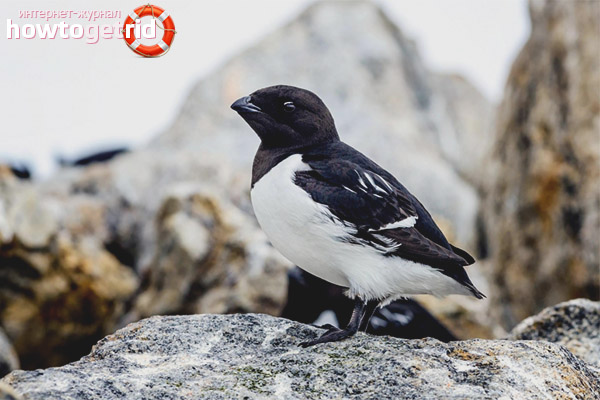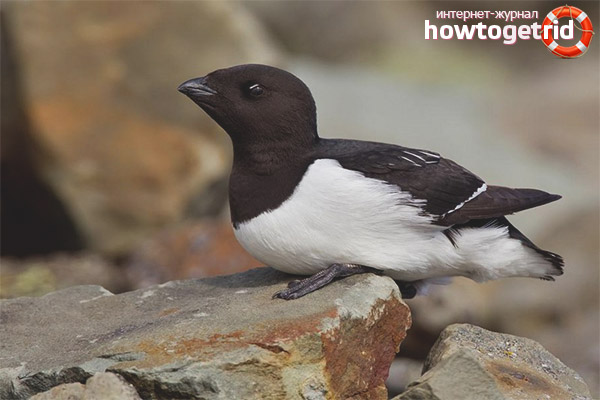The content of the article
Lurik is a bird belonging to the order Charadriiformes, it is considered to be a family of purebreds. She is a seabird, which in its size resembles a thrush. This individual is considered the smallest member of its family. The body length of an adult bird can reach 20 centimeters, and the width of its wingspan reaches 48 centimeters.
The hatch flies quickly enough, very often you can see flying close to the surface of the water, intensively working with its wings. Representatives of this species of birds swim excellently and dive perfectly, and are also able to stay under water for a long time. On land, they look quite awkward.
General information
The color of the males does not have any differences from the color of the females. These birds have a short beak, painted black, their cornea is brown in color, and their legs are painted in gray, only the membranes between the fingers along with the claws are black. In the summer, adults have black plumage of the back, as well as wings.
On the head of this bird, its throat, as well as on the front of the neck there is a plumage of dark brown color. The chest of the luric, its belly, areas located in the undertail and fragments of the sides are white in color. On the upper part of the plumage of plumage, which is of secondary importance, there is a strip painted in white.
When birds of this species acquire their winter plumage, adult individuals are covered with white plumage with characteristic variegated animals in the area located from the beak to the goiter of the bird. It is not uncommon that a white spot located in the area of the eye increases, reaching the occipital region - it seems that a white mask is put on the head of the bird.
The coloration pattern of young individuals is reminiscent of the plumage of adults in the mating season, with the only difference being that all black colors are replaced by brown. This applies even to the beak. On the throat of young individuals, noticeable streaks highlighted in a light color stand out.
Habitat
Lurik loves to arrange his nesting places in the Arctic latitudes, in the Russian Federation it can be found in the north of the European part - there birds have chosen parts of Novaya Zemlya, as well as Franz Josef Land. During periods of seasonal migrations of these birds can be found in the southern part of the Barents Sea, where they gather in large flocks.
For wintering, the lurix flies to the northern part of the Atlantic Ocean, and there the birds settle at the very edge of the ice, settling in on the vast wormwoods that are found in this region. Sometimes the local climatic conditions are accompanied by severe autumn storms, which forces migratory birds to extend their migrations to more southern latitudes. There were times when they had to reach the limits of the North Sea.
There are also known cases when these birds were met in the northern part of the Baltic states, Chuvshia and even in the Moscow region. They tolerate oil pollution very poorly (coastline or water surface).
Offspring
This species of bird prefers monogamous relationships. During nesting, they gather in large colonies, choosing mountain ranges of the coastal zone.These birds arrange their nests in various cracks and small faults on a rocky surface, and voids formed between stones may well be suitable for this purpose.
As a rule, one egg is found in the clutch of a female Lurik, it is painted in a greenish-blue hue, it is covered with rare dots, as well as speckles. Both parents are engaged in hatching offspring in turn, the incubation period of these birds is 30 days. Chicks are born covered with a down cover, which on top has a dark brown hue, and acquires pale tones towards the bottom. The chick acquires the ability to fly on the 29th day of his life, and at this time he always leaves the nest.
Diet

Lurik, like most purebreds, hunts on water. The main diet of these birds consists of various crustaceans, however, small fish are sometimes added to their prey. For hunting, these birds have to gather in large flocks.
The dangers awaiting birds of this species
Environmental pollution poses a great threat to Lurik; it happens that these birds die en masse in accidents involving oil emissions.
Scientists explain this state of affairs by global warming. The fact is that one of the largest types of crustaceans, included in the diet of northern birds, is able to live exclusively in cold water, which usually occurs among the belt of sea ice. And in warmer waters, its miniature congener lives, which is not able to fully feed the birds hunting him.
The disturbance of the planet’s ecosystem associated with global warming leads to the gradual displacement of larger crustaceans by their small relatives, which leads to a decrease in the luric populations.
Birds of this species are not devoid of natural enemies, one of the most dangerous for them is the northern gull. On the shore, the scribe poses the greatest threat.











Submit